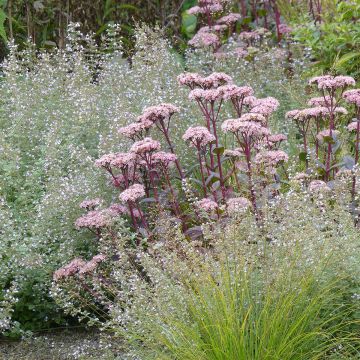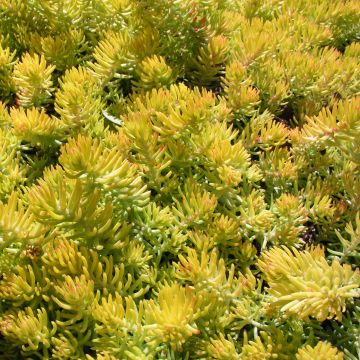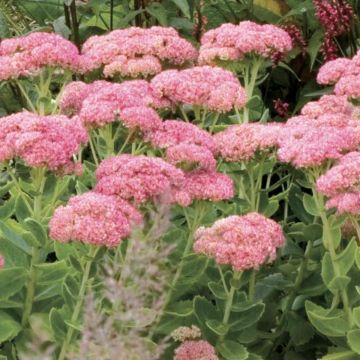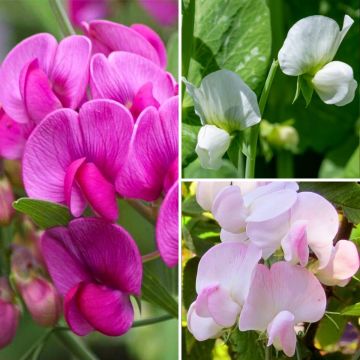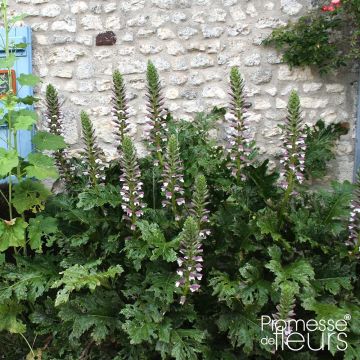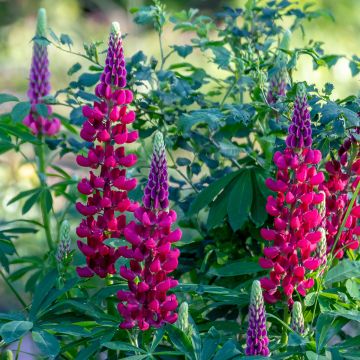

Sedum Eline - Autumn Stonecrop


Sedum Eline - Autumn Stonecrop


Sedum Eline - Autumn Stonecrop
Sedum Eline - Autumn Stonecrop
Sedum Eline®
Autumn Stonecrop
This young plant has suffered a lot during transportation. Its leaves are broken, and the heads are bent. I will try to make sure they recover, but I am a bit disappointed. The other plants in the package were in good condition, but these were too tightly packed in their packaging...
Natalia, 08/04/2020
Special offer!
Receive a €20 voucher for any order over €90 (excluding delivery costs, credit notes, and plastic-free options)!
1- Add your favorite plants to your cart.
2- Once you have reached €90, confirm your order (you can even choose the delivery date!).
3- As soon as your order is shipped, you will receive an email containing your voucher code, valid for 3 months (90 days).
Your voucher is unique and can only be used once, for any order with a minimum value of €20, excluding delivery costs.
Can be combined with other current offers, non-divisible and non-refundable.
Why not try an alternative variety in stock?
View all →This plant carries a 12 months recovery warranty
More information
We guarantee the quality of our plants for a full growing cycle, and will replace at our expense any plant that fails to recover under normal climatic and planting conditions.
Would this plant suit my garden?
Set up your Plantfit profile →
Description
Sedum 'Eline', often called Orpine, is a recent creation. It is a fleshy perennial with rare shades. Its foliage is adorned with numerous nuances: grey-green in spring, it is veined with purple during the summer season and multiplies the shimmering reflections with the arrival of autumn. Its strong and upright stems take on the same purple colour, contrasting with its beautiful cream-yellow flowering. Durable in bouquets, as well as in beds, it appreciates the sun and dry soils, and is accommodating.
Orpines are proof that poor soil can grow beautiful specimens with generous flowering. You can benefit from these hardy perennials if your soil is poor, rather dry, even rocky or slightly chalky. They resist temperatures below -15°C (5°F), require no maintenance, and promise to animate the garden with visits from butterflies. These succulents are easy to grow and have flowers and foliage with varied hues that can create dazzling displays, whether in beds or pots. On the other hand, you can also adopt them in rich, moist and heavy soil, by taking some necessary precautions. They will acclimatise without any problem if you take care to add gravel and place them in full sun. They should not be subjected to excess moisture in winter.
The 'Eline' variety presents a bushy clump spreading over 40cm (16in) in width, composed of solid and fleshy purple stems that rise up to 35cm (14in) in height. They bear deciduous, ovate, thick and flat leaves, which are arranged alternately and are sessile (without petioles). These have multiple colours: the base colour is rather bluish-grey, with some remnants of green, the veins are red, and the whole palette darkens further during the seasons. All these nuances vary, like most of its cousins in the same genus, depending on climatic conditions: the amount of light and water will either lighten or accentuate its tendencies. It is therefore a permanent spectacle. Its long-lasting flowering is perfect for both fresh and dried bouquets. The beautiful inflorescences in dense, rounded corymbs are made up of multiple small star-shaped flowers, highly prized by insects that constantly pollinate them. Pink in bud, they then evolve and open into a cream-yellow shade that slowly turns russet.
Sedum 'Eline' is a novelty that sweeps a wide range of colours. It fits into all scenarios and easily blends with shades of carmine, cream, and chocolate. It is particularly suitable for poetic and charming atmospheres. Alongside its cousins with equally shimmering hues, it adds its personal touch. Among grasses, it adds structure and colour. Plant it with asters for a beautiful transition into autumn.
Sedum Eline - Autumn Stonecrop in pictures




Flowering
Foliage
Plant habit
Botanical data
Sedum
Eline®
Crassulaceae
Autumn Stonecrop
Cultivar or hybrid
Other Sedum
View all →Planting and care
Plant Sedum 'Eline' in spring or autumn in dry, even stony, and sunny soil. It also tolerates heavy or slightly calcareous substrates. However, add gravel to the planting hole if your soil is moist or may retain some moisture in winter. Take the same precautions if you want to place it in a container.
Prune the inflorescences at the end of flowering or in early spring if you prefer to keep the dried flowers on the stems for winter decoration. Beware of gastropods that attack the leaves. Divide the stump if the centre starts to thin out. This is usually required every 3-4 years, depending on its development.
Planting period
Intended location
Care
Planting & care advice
-
, onOrder confirmed
Reply from on Promesse de fleurs
Similar products
Haven't found what you were looking for?
Hardiness is the lowest winter temperature a plant can endure without suffering serious damage or even dying. However, hardiness is affected by location (a sheltered area, such as a patio), protection (winter cover) and soil type (hardiness is improved by well-drained soil).

Photo Sharing Terms & Conditions
In order to encourage gardeners to interact and share their experiences, Promesse de fleurs offers various media enabling content to be uploaded onto its Site - in particular via the ‘Photo sharing’ module.
The User agrees to refrain from:
- Posting any content that is illegal, prejudicial, insulting, racist, inciteful to hatred, revisionist, contrary to public decency, that infringes on privacy or on the privacy rights of third parties, in particular the publicity rights of persons and goods, intellectual property rights, or the right to privacy.
- Submitting content on behalf of a third party;
- Impersonate the identity of a third party and/or publish any personal information about a third party;
In general, the User undertakes to refrain from any unethical behaviour.
All Content (in particular text, comments, files, images, photos, videos, creative works, etc.), which may be subject to property or intellectual property rights, image or other private rights, shall remain the property of the User, subject to the limited rights granted by the terms of the licence granted by Promesse de fleurs as stated below. Users are at liberty to publish or not to publish such Content on the Site, notably via the ‘Photo Sharing’ facility, and accept that this Content shall be made public and freely accessible, notably on the Internet.
Users further acknowledge, undertake to have ,and guarantee that they hold all necessary rights and permissions to publish such material on the Site, in particular with regard to the legislation in force pertaining to any privacy, property, intellectual property, image, or contractual rights, or rights of any other nature. By publishing such Content on the Site, Users acknowledge accepting full liability as publishers of the Content within the meaning of the law, and grant Promesse de fleurs, free of charge, an inclusive, worldwide licence for the said Content for the entire duration of its publication, including all reproduction, representation, up/downloading, displaying, performing, transmission, and storage rights.
Users also grant permission for their name to be linked to the Content and accept that this link may not always be made available.
By engaging in posting material, Users consent to their Content becoming automatically accessible on the Internet, in particular on other sites and/or blogs and/or web pages of the Promesse de fleurs site, including in particular social pages and the Promesse de fleurs catalogue.
Users may secure the removal of entrusted content free of charge by issuing a simple request via our contact form.
The flowering period indicated on our website applies to countries and regions located in USDA zone 8 (France, the United Kingdom, Ireland, the Netherlands, etc.)
It will vary according to where you live:
- In zones 9 to 10 (Italy, Spain, Greece, etc.), flowering will occur about 2 to 4 weeks earlier.
- In zones 6 to 7 (Germany, Poland, Slovenia, and lower mountainous regions), flowering will be delayed by 2 to 3 weeks.
- In zone 5 (Central Europe, Scandinavia), blooming will be delayed by 3 to 5 weeks.
In temperate climates, pruning of spring-flowering shrubs (forsythia, spireas, etc.) should be done just after flowering.
Pruning of summer-flowering shrubs (Indian Lilac, Perovskia, etc.) can be done in winter or spring.
In cold regions as well as with frost-sensitive plants, avoid pruning too early when severe frosts may still occur.
The planting period indicated on our website applies to countries and regions located in USDA zone 8 (France, United Kingdom, Ireland, Netherlands).
It will vary according to where you live:
- In Mediterranean zones (Marseille, Madrid, Milan, etc.), autumn and winter are the best planting periods.
- In continental zones (Strasbourg, Munich, Vienna, etc.), delay planting by 2 to 3 weeks in spring and bring it forward by 2 to 4 weeks in autumn.
- In mountainous regions (the Alps, Pyrenees, Carpathians, etc.), it is best to plant in late spring (May-June) or late summer (August-September).
The harvesting period indicated on our website applies to countries and regions in USDA zone 8 (France, England, Ireland, the Netherlands).
In colder areas (Scandinavia, Poland, Austria...) fruit and vegetable harvests are likely to be delayed by 3-4 weeks.
In warmer areas (Italy, Spain, Greece, etc.), harvesting will probably take place earlier, depending on weather conditions.
The sowing periods indicated on our website apply to countries and regions within USDA Zone 8 (France, UK, Ireland, Netherlands).
In colder areas (Scandinavia, Poland, Austria...), delay any outdoor sowing by 3-4 weeks, or sow under glass.
In warmer climes (Italy, Spain, Greece, etc.), bring outdoor sowing forward by a few weeks.



































